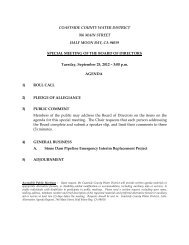Lower Pilarcitos Creek Groundwater Basin Study - Coastside ...
Lower Pilarcitos Creek Groundwater Basin Study - Coastside ...
Lower Pilarcitos Creek Groundwater Basin Study - Coastside ...
You also want an ePaper? Increase the reach of your titles
YUMPU automatically turns print PDFs into web optimized ePapers that Google loves.
Marine Terrace Hydraulic Properties<br />
The marine terrace deposits form the main aquifer of the <strong>Lower</strong> <strong>Pilarcitos</strong> <strong>Creek</strong><br />
groundwater basin. Available pumping test data from wells in the basin provide<br />
information on hydraulic properties of the marine terrace aquifer, including<br />
conductivity, transmissivity, and storativity. <strong>Groundwater</strong> flow is generally toward<br />
the shoreline, where an interface exists between the onshore fresh water and<br />
offshore salt water. Substantial discharge of groundwater occurs to the ocean.<br />
<strong>Groundwater</strong> storage is affected significantly by seasonal fluctuations in<br />
groundwater levels.<br />
Pumping Tests<br />
A handful of formal pumping tests conducted with the supervision of a<br />
hydrogeologist and many informal tests conducted without supervision have been<br />
performed and recorded in the Half Moon Bay and <strong>Lower</strong> <strong>Pilarcitos</strong> <strong>Creek</strong> areas. The<br />
formal pumping tests are analyzed and discussed by ESA (December 6, 1991, February<br />
27, 1992, and March 5, 1992) and by Luhdorff & Scalmanini (2000). Nelson (1998) did<br />
not analyze the five 12-hour pumping tests collected during the <strong>Lower</strong> <strong>Pilarcitos</strong> <strong>Creek</strong><br />
test well installation and groundwater investigation but noted the data were available in<br />
the CCWD files. Todd Engineers reviewed and analyzed the pumping test data for the<br />
current investigation (see previous section).<br />
Table 5 summarizes eight formal single well pumping tests conducted by CCWD.<br />
These tests were conducted in the vicinity of the proposed <strong>Pilarcitos</strong> <strong>Creek</strong> wellfield<br />
(cross section A-A’, Figure 16). The T-value ranges between 10,000 and 20,000 gpd/ft<br />
for the test wells and the Holiday Inn well while the wells in the southern portion of the<br />
cross section (Cunha and Corporation Yard) show a range between 1,500 and 7,000<br />
gpd/ft. Nevertheless, these are similar values considering that the transmissivity can<br />
vary by 12 orders of magnitude (Freeze and Cherry, 1979) and suggest that the aquifer<br />
is slightly less permeable south of the proposed wellfield. The K-value averages about<br />
160 gpd/ft 2 south of the proposed wellfield and 537 gpd/ft 2 near the proposed wellfield.<br />
Aquifer testing was conducted at the Balboa wellfield by Luhdorff & Scalmanini<br />
(2000). The aquifer test consisted of pumping one well at 66 gpm for eight hours and<br />
measuring the drawdown at three observation wells. Table 7 summarizes these data.<br />
The T-values estimated for the three observation wells range between 8,000 and 10,000<br />
gpd/ft; equivalent to an average K-value of 354 gpd/ft 2 . Because observation wells were<br />
used for this aquifer test, calculations can be conducted to determine the S-value of the<br />
24



